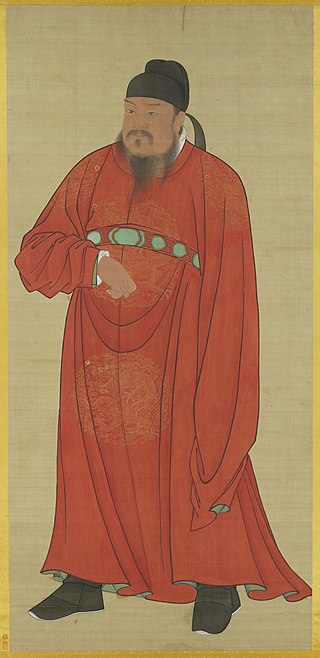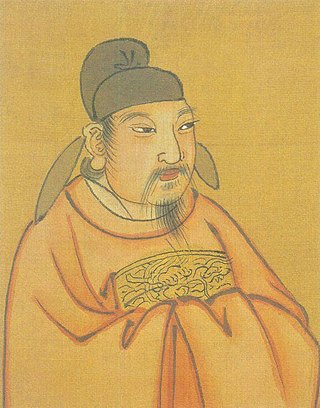Related Research Articles

Emperor Taizong of Tang, previously Prince of Qin, personal name Li Shimin, was the second emperor of the Tang dynasty of China, ruling from 626 to 649. He is traditionally regarded as a co-founder of the dynasty for his role in encouraging his father Li Yuan to rebel against the Sui dynasty at Jinyang in 617. Taizong subsequently played a pivotal role in defeating several of the dynasty's most dangerous opponents and solidifying its rule over China proper.

Emperor Gaozu of Tang, born Li Yuan, courtesy name Shude, was the founding emperor of the Tang dynasty of China, reigning from 618 to 626. Under the Sui dynasty, Li Yuan was the governor in the area of modern-day Shanxi, and was based in Taiyuan.

Emperor Xianzong of Tang, personal name Li Chun, né Li Chun (李淳), was an emperor of the Chinese Tang dynasty. He was the eldest son of Emperor Shunzong, who reigned for less than a year in 805 and who yielded the throne to him late that year.
Wang Yuanji was a Chinese noble lady, aristocrat and later empress dowager of the Jin dynasty, who lived in the state of Cao Wei during the Three Kingdoms period of China. She was the wife of Sima Zhao, a regent of Cao Wei. She became the empress dowager during the reign of her son Sima Yan, who ended the Wei regime and founded the Jin dynasty. She was posthumously honoured as "Empress Wenming" after her death.
Wang Su (195–256), courtesy name Ziyong, was an official and Confucian scholar of the state of Cao Wei during the Three Kingdoms period of China. He was a son of Wang Lang. When Guanqiu Jian started a rebellion in Shouchun, Wang Su advised Sima Shi to lower the rebels' morale by treating their families with respect. Following that, Wang Su entreated Cao Mao to allow Sima Zhao to succeed Sima Shi as regent of Wei.
Jin Xuan, courtesy name Yuanji, was an official and minor warlord who lived during the late Eastern Han dynasty of China.
Li Feng, courtesy name Anguo, was a Chinese politician of the state of Cao Wei during the Three Kingdoms period of China. He was a trusted official of the third Wei emperor Cao Fang, and did not follow the regent Sima Shi's wishes.
Xiao Dong, courtesy name Yuanji (元吉), sometimes known by his pre-ascension title of Prince of Yuzhang (豫章王), was briefly an emperor of the Chinese Liang Dynasty. In 551, with the general Hou Jing in control of the imperial government at the capital Jiankang, Hou, wanting to show off his strength, deposed Xiao Dong's granduncle Emperor Jianwen and replaced him with Xiao Dong, the grandson of Emperor Jianwen's older brother Xiao Tong, who was originally the founder Emperor Wu's crown prince.
Huang Yuanji a character featured within the famed classic Chinese novel Investiture of the Gods.
Nangong Kuo was a top official of King Wen of Zhou during the late Shang and early Western Zhou dynasties. In the "Jun Shi" (君奭) chapter of the Classic of History, the Duke of Zhou names him as one of the five key advisers of King Wen, together with Guo Shu, Hong Yao, Tai Dian, and San Yisheng. After King Wen's death, Nangong Kuo became a key adviser of his son King Wu.
Liu Heita was an agrarian rebel leader during China's transition period from the Sui dynasty to the Tang dynasty, who initially successively served under Hao Xiaode (郝孝德), Li Mi, and Wang Shichong. He eventually followed Dou Jiande the Prince of Xia. After Dou was killed by Emperor Gaozu of Tang in 621 and his territory was taken by Tang, Liu rose to avenge Dou, and briefly recaptured Dou's territory, north of the Yellow River.

Luo Yi, known during service to the Tang dynasty as Li Yi (李藝), courtesy name Ziyan (子延) or Ziting (子廷), was a Sui dynasty official who rose against the rule of Emperor Yang of Sui and occupied the modern Beijing region. He subsequently submitted to Emperor Gaozu of Tang and was created the Prince of Yan and granted the imperial surname of Li. He subsequently, in the struggle between Emperor Gaozu's sons Li Jiancheng the Crown Prince and Li Shimin the Prince of Qin, joined Li Jiancheng's faction. After Li Shimin killed Li Jiancheng in 626 and forced Emperor Gaozu to yield the throne to him, Li Yi was fearful, and he rebelled against Emperor Taizong in 627. He was soon defeated and killed.
Li Jiancheng (Chinese: 李建成; pinyin: Lǐ Jiànchéng; 589 – July 2, 626, formally Crown Prince Yin, nickname Vaishravana, was the first crown prince of the Chinese Tang dynasty. He was the oldest son of the founding emperor Emperor Gaozu and the crown prince after the founding of the dynasty in 618 CE.
Li Yuanji, formally Prince La of Chao (巢剌王), more commonly known by the title of Prince of Qi (齊王), nickname Sanhu (三胡), was an imperial prince of the Chinese Tang dynasty. He was a son of the dynasty's founder Emperor Gaozu of Tang, and in the intense rivalry developed between his older brothers Li Jiancheng the Crown Prince and Li Shimin the Prince of Qin, he sided with Li Jiancheng and often advocated drastic actions against Li Shimin, including assassination. In 626, Li Shimin, fearing that Li Jiancheng and Li Yuanji were about to kill him, laid an ambush for them at Xuanwu Gate outside the palace and killed them. Li Shimin then effectively forced Emperor Gaozu to yield the throne to him.

The Xuanwu Gate Incident was a palace coup for the throne of the Tang dynasty on 2 July 626, when Prince Li Shimin and his followers assassinated his brothers Crown Prince Li Jiancheng and Prince Li Yuanji. Li Shimin, the second son of Emperor Gaozu, was in an intense rivalry with his brothers. He took control and set up an ambush at Xuanwu Gate, the northern gate leading to the Palace City within the imperial capital Chang'an. There, Li Jiancheng and Li Yuanji were murdered by Li Shimin and his men. Within three days after the coup, Li Shimin was installed as the crown prince. About two months later, Emperor Gaozu abdicated and passed the throne to Li Shimin, who would become known as Emperor Taizong.
Wang Gui (571–639), courtesy name Shujie, posthumously known as Duke Yi of Yongning, was a Chinese official who served as a chancellor during the reign of Emperor Taizong in the Tang dynasty. He had previously served Li Shimin's elder brother, Li Jiancheng, with whom Li Shimin was locked in an intense rivalry during the reign of their father, Emperor Gaozu, but after Li Shimin killed Li Jiancheng and then took the throne, he knew that Wang was faithful to Li Jiancheng and was capable, and therefore retained him, eventually making him chancellor. Wang was known for his honest and blunt criticism of the emperor, and for that was honored by Taizong, who appreciated such criticism.
The decade of the 1060s in art involved some significant events.

Yi Yuanji was a Northern Song dynasty painter, famous for his realistic paintings of animals. According to Robert van Gulik, Yi Yuanji's paintings of gibbons were particularly celebrated.

Yi (易), Yick, or Yik is a Chinese surname. A 2013 study found that it was the 114th most-common name, shared by 1.75 million people, or 0.130% of the population, with the largest province being Hunan.

The Reign of Ren and Xuan refers to the reigns of the Hongxi Emperor and the Xuande Emperor, during which they adopted the policy of Jian Yi (蹇義), the Grand Secretaries Yang Shiqi (楊士奇), Yang Pu (楊溥), Yang Yong (楊榮), Xia Yuanji, and of loosely governing the country and resting troops to support the people. This made the eleven-year period of their reign (1424–1435) an era of clarity in the administration of officials, economic development, and social stability in Ming history.
References
- ↑ "Yuanji, Yi". The Famous Artists.